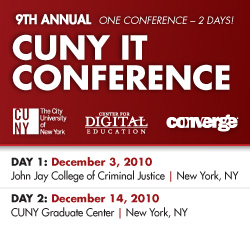Think of it: students can lower their debt, enhance their chances for success, take more classes, and graduate sooner.
Teachers can have more engaged students, better passing rates, and more flexibility with the course materials.
Let’s throw in the bonus of helping to save the planet.
I am not describing the future. This is now.
How can we accomplish all this? It’s easy. We offer every student at CUNY free textbooks. At the CUNY IT Conference on December 3rd, I presented on the topic of open textbooks to a standing room only crowd with about a dozen people forced to stand in the hallway trying to catch some of what was said.
As we all know, the exorbitant cost of college textbooks is crippling CUNY’s mission to bring higher education to striving New York City students. Students at CUNY community colleges spend, on average, $1,000 per year on textbooks—an amount equal to 34% of their tuition. Faced with such costs, many students reduce their course loads, slowing their progress toward their degrees, and—too often—leading them to drop out. Some 50% of students enrolled in classes try to get by without purchasing the costly textbooks, here again lowering their chances for success. Community colleges, both here in New York and across the country, see the results in distressingly low completion rates.
We can expect no help from the profit-driven textbook industry. In seven years textbook prices rose 186%–double the rate of inflation.
But, we don’t need their help.
Here are just two examples of how we can work without a bookstore.
Introduction to Economic Analysis is being used at Harvard, NYU, Caltech, and I can’t tell you how many other colleges and universities. It was written by R. Preston McAfee, recently of Caltech, who has held four endowed chairs in economics. This book is available to students, online . . . FREE. (A printed copy will cost students $15.20)
Collaborative Statistics written Barbara Illowsky & Susan Dean, used at Emory, Virginia Tech, SUNY Purchase, and elsewhere is also online free.
Today there are thousands of these textbooks, in virtually every subject area, written by eminent scholars, professionally edited, widely reviewed, and available to students online at no cost. These Open Educational Resources (OER) offer a real, lasting solution to the textbook problem CUNY has recognized and grappled with.
Open Educational Resources offer not an acceptable substitute for traditional textbooks, but texts that are actually superior in important ways.
First, they are easy to use. Students can read the text in various formats. Highlight and make notes. Print a page they want, several pages–the entire book, if they wish. Convenient text features include vocabulary words that automatically link to their definitions, so students don’t have to thumb through a glossary in the back of the book. There are even adaptive features for students with disabilities.
Second, these textbooks open a new world of flexibility for teachers. Instructors can choose the best chapters from different texts—why not since they all are free? Until now teachers have often passed up valuable materials, because they couldn’t justify having students buy a whole book when they’re only going to use a small portion of it.
Teachers can also modify the contents of open texts. Change parts, add related materials from elsewhere. Revise text to emphasize particular points, make it more accessible or relevant to their students’ experiences.
We need to expand this effort here at CUNY. And then we need to move from generating support for the concept—which is easy—to the difficult work of implementation. Adopting new textbooks is a major undertaking. Researching the books themselves is very time-consuming: as I mentioned, there are thousands. The ability to combine and/or modify the books complicates the process further. If books are to be adopted department-wide, a committee must do the work together; consensus must be built.
Funding is needed to enable faculty to take on this work. Importantly, this funding, unlike annual funds to abate textbook costs, is temporary. Once free textbooks are adopted, they’re free—for one class of students after another. And once teachers discover what they can do with open resources, I cannot imagine their ever going back.
I am seeking funding from the NYC Council to whom I spoke as part of the CUNY contingent on 11/29, and also from CUNY to implement a pilot program at Bronx CC.
I close with the words of Thomas Jefferson, words I have read in three different publications in just the last week: “The field of knowledge is the common property of mankind.” That vision—which is the vision that inspirits the City University of New York—is today, as never before in history, a living reality. Today, NYC students, for whom textbooks costs have been a crushing burden, can start using world class textbooks—for FREE.
What a wonderful world it can be.




